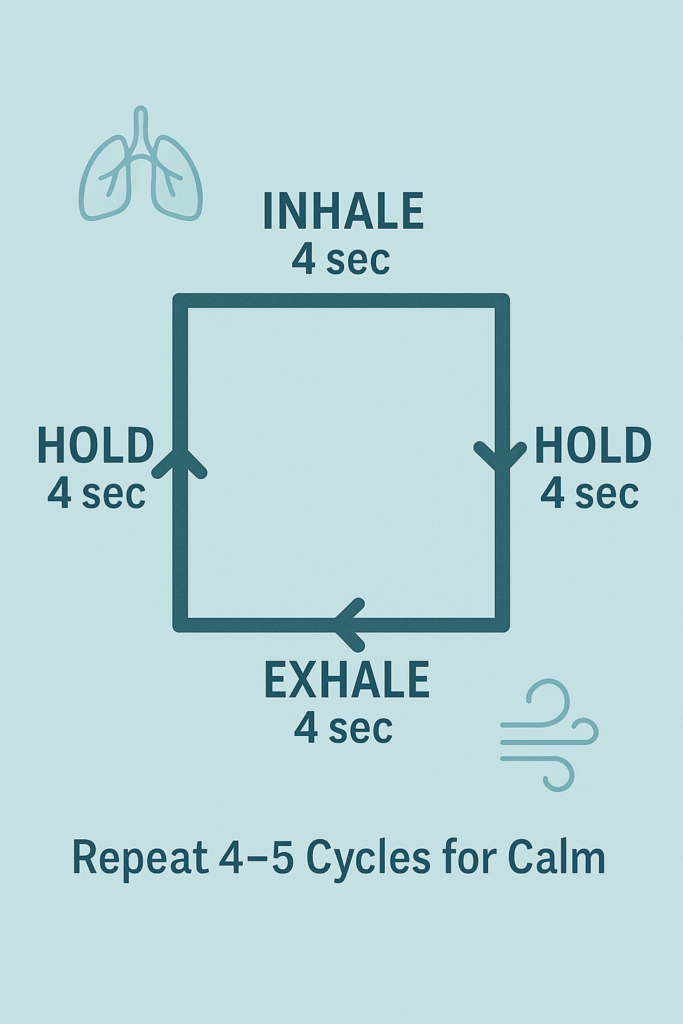When stressed, your body’s biological responses activate. The HPA axis releases cortisol, the main stress hormone, priming you for ‘fight or flight.’ At the same time, your sympathetic nervous system increases heart rate, blood pressure, and muscle tension. Over time, prolonged stress can upset hormonal balance, disrupt sleep, weaken immunity, and lower serotonin and dopamine—key mood-regulating neurotransmitters. The good news? Relaxation practices activate the parasympathetic nervous system (‘rest and digest’), helping rebalance hormones and restore equilibrium.

1. Box Breathing
Box breathing, sometimes called square breathing, is a controlled breathing technique practiced by Navy SEALs to maintain composure in high-stress situations. It helps stabilize the nervous system, reduce heart rate, and enhance mental clarity.
How to Practice Box Breathing:
- Sit comfortably with your back straight.
- Inhale through your nose for 4 seconds.
- Hold your breath for 4 seconds.
- Exhale slowly through your mouth for 4 seconds.
- Hold your breath again for 4 seconds.
- Repeat for 4-5 cycles or until you feel calmer.
Why It Works: Box breathing helps restore balance between oxygen and carbon dioxide in the body, triggering the parasympathetic nervous system to induce calm. Simple, portable, and powerful, it’s a go-to tool for managing stress in demanding situations.

2. Progressive Muscle Relaxation (PMR)
PMR works by tensing and relaxing muscle groups to ease physical and mental stress, ideal for people who hold tension in their bodies.
How to Practice PMR:
- Find a quiet space and sit or lie down.
- Starting with your forehead, tense the muscles for 5-10 seconds, then release.
- Move to your jaw, shoulders, arms, hands, chest, and so on, down to your toes.
- Breathe deeply as you release each muscle group.
Why It Works: By focusing on physical sensations, PMR distracts the mind from stressors and promotes body awareness, reducing anxiety.
3. Grounding (5-4-3-2-1 Technique)
Grounding uses your senses to anchor you in the present, making it ideal for moments of panic or overwhelm.
How to Practice:
- Name 5 things you can see around you.
- Name 4 things you can touch.
- Name 3 things you can hear.
- Name 2 things you can smell.
- Name 1 thing you can taste.
- Repeat if needed.
Why It Works: This technique shifts focus from internal anxiety to external reality, calming the mind by engaging sensory awareness.
4. Deep Diaphragmatic Breathing
Also known as belly breathing, this technique stimulates the vagus nerve, promoting relaxation and reducing cortisol levels. Studies show that slow, deep breathing increases heart rate variability (HRV), an indicator of resilience to stress.
How to Practice: Inhale deeply through your nose for 4 counts, hold for 4 counts, and exhale slowly through your mouth for 6–8 counts. Repeat for 5–10 minutes.
5. Cold Water Face Immersion
Splashing cold water on your face or immersing it triggers the mammalian dive reflex, which slows the heart rate and activates the parasympathetic nervous system almost instantly. This can be particularly useful during acute anxiety episodes.
How to Practice: Submerge your face in cold water for 15–30 seconds or gently splash cold water over your face when feeling overwhelmed.
6. Gentle Movement: Yoga and Tai Chi
Tai Chi isn’t just a long, formal practice—it can be a quick and effective way to reset your mind and body, even during a busy day. Just a 5-minute Tai Chi session during a work or lunch break can help release physical tension, calm racing thoughts, and activate the parasympathetic nervous system. Its flowing, mindful movements improve circulation and reduce cortisol, making it a powerful micro-break for both mental clarity and relaxation.
How to Practice: Find a quiet space, stand comfortably, and follow a simple guided video for a short session. Even a few slow, mindful movements can make a noticeable difference.
Tips for Success
- Practice Regularly: Like any skill, calming techniques become more effective with consistent practice.
- Mix and Match: Experiment to find what works best for you. Some prefer active techniques like PMR, while others gravitate toward quiet practices like mindfulness.
- Create a Routine: Incorporate one or two techniques into your daily schedule, such as box breathing in the morning or grounding before bed.
- Seek Professional Help if Needed: If stress or anxiety feels unmanageable, consider consulting a therapist or counselor for tailored support.

Conclusion
Relaxation methods such as box breathing, progressive muscle relaxation, mindfulness meditation, grounding, visualization, and journaling help you manage your mental and physical health. Regularly using these tools can strengthen stress resilience and foster deeper calm in everyday life. Begin with small steps, stay consistent, and find what works best for you. Your mind and body will benefit.
References
- McEwen, B. S. (2007). Physiology and Neurobiology of Stress and Adaptation: Central Role of the Brain. Physiological Reviews, 87(3), 873–904.
- Thayer, J. F., & Lane, R. D. (2000). A Model of Neurovisceral Integration in Emotion Regulation and Dysregulation. Journal of Affective Disorders, 61(3), 201–216.
- Zeidan, F. et al. (2010). Mindfulness Meditation Improves Cognition: Evidence of Brief Mental Training. Consciousness and Cognition, 19(2), 597–605.
- Conrad, A., et al. (2007). Effects of Progressive Muscle Relaxation on Anxiety and Cardiovascular Reactivity. Journal of Clinical Psychology, 63(3), 241–250.

